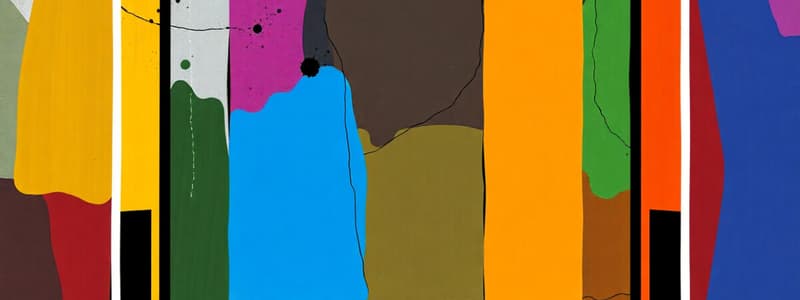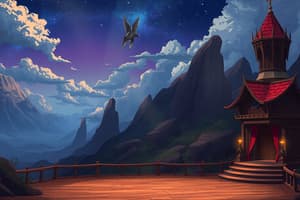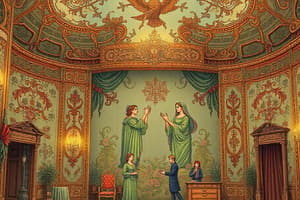Podcast
Questions and Answers
What is the primary role of a Scenic Designer?
What is the primary role of a Scenic Designer?
- To communicate rehearsals to the actors
- To create costumes that match the story's theme
- To design the location to support the story being told (correct)
- To manage the lighting during the performance
What type of props includes items like tables and tree stumps?
What type of props includes items like tables and tree stumps?
- Scenic props (correct)
- Set dressing
- Stage properties
- Hand props
Which person is primarily responsible for determining how the set will be built?
Which person is primarily responsible for determining how the set will be built?
- Stage Manager
- Scenic Designer
- Technical Director (correct)
- Director
Which of the following is a step in the design process?
Which of the following is a step in the design process?
What is the focus of the lighting designer primarily based on?
What is the focus of the lighting designer primarily based on?
What is typically NOT a type of prop used in performances?
What is typically NOT a type of prop used in performances?
Why might a set designer need to update sketches after discussions with the director?
Why might a set designer need to update sketches after discussions with the director?
What role does the Stage Manager primarily serve in creating the set?
What role does the Stage Manager primarily serve in creating the set?
What purpose does a set designer have for rereading the script?
What purpose does a set designer have for rereading the script?
What is the primary benefit of drawing items to scale in set design?
What is the primary benefit of drawing items to scale in set design?
How does the ground plan differ from a traditional architectural plan?
How does the ground plan differ from a traditional architectural plan?
What does a ½ inch scale represent in set design?
What does a ½ inch scale represent in set design?
What is typically included in a name plate for a set design project?
What is typically included in a name plate for a set design project?
What is a characteristic of a rendering created by designers?
What is a characteristic of a rendering created by designers?
Why do scenic designers angle walls outward in box sets?
Why do scenic designers angle walls outward in box sets?
What is one purpose of the research phase in the design process?
What is one purpose of the research phase in the design process?
Flashcards
Scenic Design
Scenic Design
The process of designing the location on stage to support the story of a play.
Scenic Designer
Scenic Designer
The person (or team) responsible for creating the location and supporting details that amplify the story in a play.
Design Process (steps)
Design Process (steps)
The sequence of actions a designer takes to create a set, including reading the script, research, sketching, discussions w/ the director, and creating technical drawings.
Director's Role
Director's Role
Signup and view all the flashcards
Props
Props
Signup and view all the flashcards
Technical Drawings
Technical Drawings
Signup and view all the flashcards
Lighting Designer's Role
Lighting Designer's Role
Signup and view all the flashcards
Costume Designer's Role
Costume Designer's Role
Signup and view all the flashcards
What is a 'Ground Plan'?
What is a 'Ground Plan'?
Signup and view all the flashcards
Why does a set designer need to reread the script?
Why does a set designer need to reread the script?
Signup and view all the flashcards
What kind of research might a set designer need to do?
What kind of research might a set designer need to do?
Signup and view all the flashcards
What is 'scale' in set design?
What is 'scale' in set design?
Signup and view all the flashcards
Explain half inch scale (1/2 inch scale)
Explain half inch scale (1/2 inch scale)
Signup and view all the flashcards
Explain quarter inch scale (1/4 inch scale)
Explain quarter inch scale (1/4 inch scale)
Signup and view all the flashcards
What is a 'Rendering'?
What is a 'Rendering'?
Signup and view all the flashcards
Why might a set designer sometimes create 'stylized renderings?
Why might a set designer sometimes create 'stylized renderings?
Signup and view all the flashcards
Why are walls in box sets angled?
Why are walls in box sets angled?
Signup and view all the flashcards
Study Notes
Scenic Design Unit Notes
- Scenic design involves creating locations to support the story of a play. A person (or team) works on this.
- The director, scenic designer, technical director, and stage manager all collaborate to ensure the set supports the play's story.
- The director shares the overall storytelling vision for the play.
- The technical director determines how the set will be built.
- The stage manager communicates information from rehearsals about the sets and props.
- Props include: scenic props (tables, chairs, tree stumps), hand props (pens, books, cups, knives), and set dressing (curtains, books, pillows, pictures). Set dressing are items the actors don't touch, but decorate the space.
- The design process includes: reading the script, taking notes, sketching, talking to the director, updating sketches, research, finalizing design, creating a ground plan, rendering drawings, and building a model.
- The designer and director communicate frequently throughout the design process.
- The lighting designer creates visual lighting looks concerning things like atmosphere and time of day. They need to know about the set and the costume design before setting lighting colours.
- Costume designers create costumes based on character, vision, and time period. Costumes need to work with characters and the set.
- A ground plan is a bird's-eye view of the stage space. An important detail in the ground plan is to remove the fourth wall, and to angle the walls outward to support audience sightlines.
- Scale in the design can shrink down a large space on a smaller area. For example, 1/2 inch scale means that 1-foot of space is represented by 1 1/2 inches on a piece of paper. Drawings to scale are imperative in scene design. Likewise, 1/4 inch scale represents 1-foot length by 1 1/4 inches on a piece of paper.
- Rendering is a colourful front view drawing used during design.
- Designers typically create stylised renderings.
- Designers may include drawings of characters or people standing in the rendering to show how the final design will look.
- In perspective drawings, items closer to the front of the stage are usually drawn larger and more prominent than those further back.
- Important technique to note for perspective is to ensure furniture, etc., remain in line with the ground and do not float.
- Drawing symbols are necessary in scene design, including for door depictions, window depictions, and for depictions of furniture on the stage. For example, staircases have arrows to show direction.
Studying That Suits You
Use AI to generate personalized quizzes and flashcards to suit your learning preferences.




